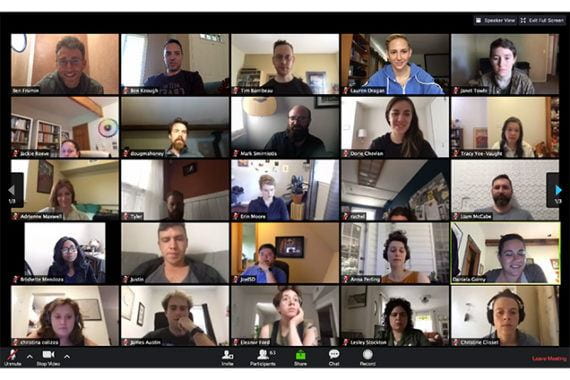 While faculty members traditionally work to create a learning community in face-to-face classes, a common mistake in translating educational work online is to see the process as individualistic. Earlier in this decade, nearly 80 percent of elearning was designed for solo work, which in effect made it little different from correspondence courses (Galvin, 2001). Research has shown that learning:
While faculty members traditionally work to create a learning community in face-to-face classes, a common mistake in translating educational work online is to see the process as individualistic. Earlier in this decade, nearly 80 percent of elearning was designed for solo work, which in effect made it little different from correspondence courses (Galvin, 2001). Research has shown that learning:
“…is enhanced when it is more like a team effort than a solo race. Good learning, like good work, is collaborative and social, not competitive and isolated. Working with others often increases involvement in learning. Sharing one’s own ideas and responding to others’ reactions improves thinking and deepens understanding” (Chickering and Gamson, 1987, p. 1).
We tend to agree with Palloff and Pratt (2007), who suggested that community is the central feature of online courses. They noted that the interaction and presence of the people in a community, coupled with processes that are reflective, constructivist, and social – and guided by articulated purpose – can lead to the types of outcomes one desires in education – co-created knowledge, increased self-direction and transformed self-learning.
Palloff and Pratt (2007) go on to suggest that community is developed online by:
- Active interaction involving both course content and personal communication
- Collaborative learning evidenced by comments directed primarily student to student rather than student to faculty
- Socially constructed meaning evidenced by questioning, reflection and agreement
- Sharing of resources among students
- Expressions of support and encouragement exchanged between students as well as from faculty, including willingness to critically evaluate the work of others
For community to develop, your students need to sense the presence of you and each other in order to begin to build trust. Palloff and Pratt suggest that the keys to creating a successful learning community revolve around “honesty, responsiveness, relevance, respect, openness, and empowerment” (p. 22).
Building this community starts in the first week of an online course. We have used online ice breakers during the first week to humanize the individuals in the community, illustrating both the similarities of the members and their individual uniquenesses.
Melissa Wehler suggested five ways to build community in online classes:
- Make yourself available. As the professor, you are the touchstone of your online course community, which means you need to model citizenship in your course. Upload a photo and provide instructions for students to do the same. Personalize your course wherever you are able by using original video announcements, overviews, and lectures. Establish the tone of the community through class correspondence, discussion board replies, and assessment feedback. Often, this also requires you to give students some of yourself (an anecdote about your weekend or a link to something you found interesting). When students are comfortable with you, they are more comfortable learning, participating, and sharing in the learning environment.
- Create a communication plan. Communication is essential to any relationship, and before you ask students to put themselves out there, you have to show them that it’s safe to do so. Before the start of a semester, create a calendar of when you will reach out to each student individually. After the first week, reintroduce yourself and let them know that you’re available to them. Before and after midterms are great opportunities for confidence-boasting. And before finals is a good time to remind them that your door (or inbox!) is always open. These communications reinforce the importance of individual attention and personalized education.
- Encourage interaction. Classroom interactions happen by proximity in the brick-and-mortar classroom, but in the online classroom, you have to be more deliberate about student-student and student-faculty exchanges happen. “In” the classroom, you can use synchronous sessions, communal discussion boards, group projects, student presentations, wikis, and peer review groups. “Out” of the classroom, you can help create study groups and establish crowd-sourced notes. Like all interactions, these should be meaningful, relevant, and theorized to avoid confusion or resentment that can sometimes result from group interactions. When done successfully, however, these interactions create not only a community of learners but can also become lasting friendships.
- Build “outside class” spaces. Unlike the brick-and-mortar classroom, online classrooms can feel all encompassing, lacking the traditional space and time borders that demarcate the classroom. This often means that there is no “before” or “after” class when much of community-building often occurs. In an online course, you have to consciously build in these “outside” spaces that are free from content delivery and assessment. Make “water cooler” or “café” discussion boards where the class can talk about current events and common interests. Create a social media page for the class where ideas can be shared. Watch a virtual event together and discuss it afterwards. Deliberately creating social moments acknowledges this fundamental aspect of education.
- Bring the outside in. Paradoxically, online courses can also feel compartmentalized and isolated from the wider campus community. In our courses, we need to remind students that they are a part of large campus culture. Post announcements about events happening on campus. Assign attendance at webinars and live-streaming events for course credit. Encourage them to take part in campus organizations that are especially friendly to distance and continuing education student. Explain how to access student support and resources. As possible the only touchstones to campus, faculty members have to be ambassadors for the college community.